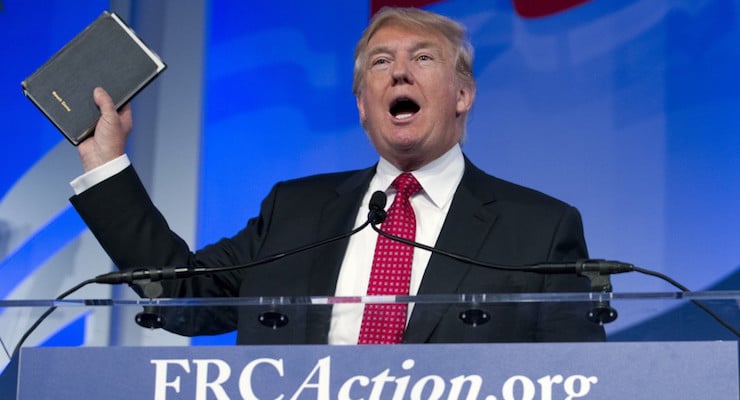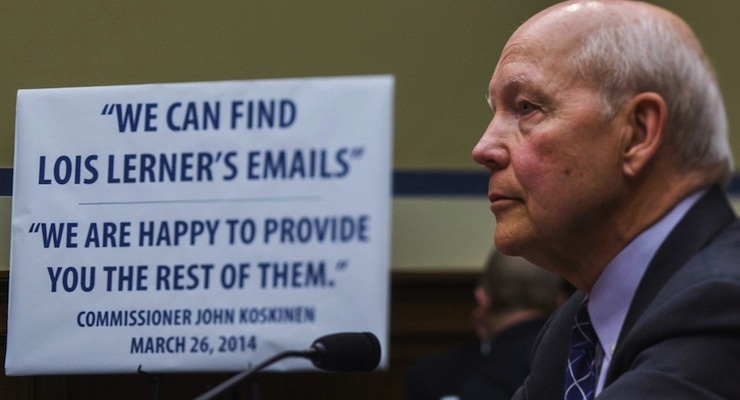
Donald Trump, holds up his Bible as he speaks during the Values Voter Summit Sept. 25 in Washington (Photo: AP/Jose Luis Magana)
In recent presidential years, Catholics and white evangelical Christians joined in favoring the Republican candidate. A key reason was a shared opposition to abortion.
This time, Catholics appear to be deserting the candidacy of Donald Trump, and one can understand why. Trump is the most vulgar, least moral presidential candidate in modern memory — by Christian or any other ethical standards.
But why are 78 percent of white evangelicals reportedly sticking with a mobbed-up casino con man gone six-time bankrupt? How can they support a thrice-married libertine who brags about his genitalia?
Do note that some prominent Christian conservatives are appalled by this alliance. Moral Majority co-founder Michael Farris saw the “pilgrimage” of 1,000 evangelical leaders to Trump Tower as “the end of the Christian Right.”
Farris was not invited. The event was a Trump sales job, not a discussion.
David Cay Johnston offers a full account of Trump’s un-Christian behavior — personally and in business — in his new book, “The Making of Donald Trump.” Though he’s been covering Trump for decades, the Pulitzer Prize winner still expresses shock at the depths of Trump’s moral depravity.
Johnston devotes a chapter to Trump’s vindictive campaign to deny health coverage to his nephew’s desperately ill baby. The candidate’s actions stand out for their satanic cruelty.
In 1999, William Trump was born in crisis. The infant immediately developed seizures; his breathing stopped twice. (He later developed cerebral palsy.) The medical bills to save the infant were enormous.
Fortunately, the patriarch, Fred Sr. (who died days earlier), had provided all family members with health insurance through his real estate business — or so it was assumed. The Trump family lawyer instructed the family health plan to cover “all costs related to baby William’s care.”
Then Donald stepped in. When Fred Sr.’s will was filed in probate court, William’s father, Fred III, learned that his father’s line had been pretty much left out of the estate, leaving Donald and the other siblings all the richer.
Fred Sr. had apparently disapproved of Fred Jr.’s decision to become a pilot and of the flight attendant he married. And Donald had his elderly father’s ear.
William’s parents challenged the will. Donald retaliated by denying the family health coverage.
The New York Daily News queried Trump about William. Donald replied, “Why should we give him medical coverage?”
At a meeting last year with evangelical voters in Iowa, Trump was asked whether he felt bad about William. He responded that he never had a reason to seek God’s forgiveness.
“Why do I have to, you know, repent, why do I have to ask for forgiveness if (I’m) not making mistakes?” Trump said the following day. In reporting on the event, The Christian Post carried the quote and referred to Trump’s “alleged Christian faith.”
“Always get even,” Trump wrote in one of his books. “When you are in business you need to get even with people who screw you. You need to screw them back 15 times harder … go for the jugular, attack them in spades!”
In “An Appeal to Our Fellow Catholics,” 37 leading Catholic thinkers wrote that Trump’s record and campaign “promise only the further degradation of our politics and our culture.” They urged Catholics to reject him.
Trump, meanwhile, has given Christian conservatives almost nothing, not even on the abortion issue. Farris notes that Trump “took at least three conflicting positions on abortion in a 24-hour period.”
Others may explain why people purporting to be socially conservative would back a mocker of morality while portraying Hillary Clinton, a devoted Methodist, as some kind of monster. They may not like Clinton on a number of counts. We get that. But surely, there are convictions worth defending.











